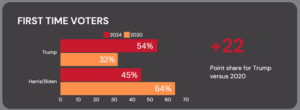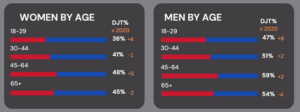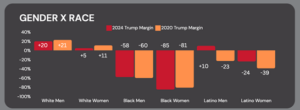So that happened. Arizona and Michigan aren’t quite finished counting, and Nevada’s Senate race is extremely close, but the big picture result is set.
Before 2AM Donald Trump had clearly won enough electoral votes to become the 47th President of the United States. If you were watching carefully (more on this below) you knew long before then that this was his night.
In hindsight the drivers behind this election seem pretty clear, and many were things we’ve been pointing out for months. (And that those who wanted to deny the resulting picture have been trying to deny.) Here are some of the key facts that drove the election:
The underlying narrative favored Trump.
• As we have noted for months, the high levels of dissatisfaction with the economy, the border, and general feeling that the country was on the wrong track all favored Trump over Harris.
• To a large extent Trump successfully framed the ballot question into some variant of “do you think the people in charge are working for your interests, or do you want me to make changes.” (Many did.)
• Harris built a contrast with Trump, but that contrast boiled down to Trump versus an unsatisfactory status quo, not two competing visions of change.
New voters were Trump voters.
• We’ve been saying for more than a month that the zero of 4 voters in our polls were overwhelmingly voting for Trump.
• In the early vote, Trump produced tens of thousands of more votes from Republicans who hadn’t voted before than Harris did from Democrats. When you added infrequent voters showing up this year, those number became even more massive.
• The exit polls confirm this trend. In 2020, Biden won first-time voters by 32 points. This year Trump won them by nine.

The kids are alright.
- Joe Biden won voters 18-29 by 24 points in 2020. According to the exit polls so far (usual caution about non-final weighted exits), Kamala Harris won them by just 13 points.
- In 2020, the oldest tranche in that 18-29 grouping were Millennials, four years on and it’s almost wholly a Gen Z voting bloc.
- We’ve been saying all year that Gen Z voters are not Millennials and that there were some early indications of an openness of at least some in Gen Z to shift back to Republicans. Data on values propositions like a return to church attendance among particularly some Gen Z men supported this.
- A lot will be made of Trump’s outreach to Gen Z men through podcasts and other non-traditional channels, and that is certainly part of the puzzle, but the left-wing dismissiveness of the “Bro-volution,” as one pundit called it last night, risks missing a real cultural change in young America.
- And let us note that there was a smaller, but present, rightward shift among women in this age range as well.

Donald Trump had a historically good performance with Hispanics, particularly Hispanic men.
- Trump lost Hispanics by just eight points, besting George W. Bush’s nine-point loss in 2004 and blowing away the performances of every other Republican this century.
- Trump won Hispanic men by ten points, a 33-point shift from 2020, and narrowed Democrats’ lead with Hispanic women by 15 points.
- We did a lot of Hispanic focus groups this year and the story we heard over and over again was that the Biden-Harris immigration policies were bringing crime and danger into their communities and that the Biden-Harris economy was failing them.
- Democrats countered this with “Latinx,” “representation,” and accusations of racism. Those may have played well in ethnic studies departments and with the punditry, but they fell flat with real voters leading real lives.
- In fact, it is important to note that we are looking at a major shift – the GOP is moving toward having a more diverse coalition than the Democratic party. The Democrats are increasingly dependent on only two demographics: college-educated white women and urban African-Americans.
Kamala Harris had an African American vote problem and an urban problem.
- One of the first warning signs for Harris was a Trump win in heavily Black Baldwin County, Georgia. After going for both Clinton and Biden by nearly two points in 2016 and 2020, it swung to a two-point Trump win this year.
- That kind of small, but meaningful shift would show up across the country. As of this moment, with votes still being counted, Harris is winning places like Philadelphia, Milwaukee, and Detroit by five to ten points less Joe Biden did four years ago.
- The exit polls don’t suggest that Harris did worse among Black voters, her margins are the same as Biden’s, but Black turnout, which was down in the early vote, continued to underperform.

Kamala Harris is no Scranton Joe.
- Joe Biden, in his current diminished state, wouldn’t have won this election. But Kamala Harris couldn’t hold onto some key parts of Biden’s coalition.
- Biden won the union vote in 2020 by 16 points. Harris won it this year by just 10 and we suspect that if you excluded public sector union members, the shift would have been even more stark.
- Trump beat Biden among white Catholics by just 12 points in 2020. He beat Harris by 23.
- This shift played out in key places like Erie and Bucks counties in Pennsylvania, both of which flipped from narrow Biden wins to narrow Trump wins.
But What About the Polls?
A few notes about polling, and we’ll have a lot more to say about this in the week ahead. There really seem to have been three types of polls and pollsters his year:
- Those who learned the lessons of 2016 and 2020, made sensible methodological adjustments and more or less got things right.
- Those who stubbornly refused to do the things that most (not all) campaign pollsters did and continued to not weight on education and/or not make partisan non-response adjustments to their polls, including on past election recall. These pollsters, many of them well-known, looked foolish last night. If these pollsters want to continue to stubbornly make the theoretical argument that these non-response adjustments are wrong, they really owe it to their editors/sponsors/just the public in general to propose some alternate method of fixing their issues. Because they’ve not been wrong for three consecutive Presidential elections, in the exact same direction, and for the exact same predictable reasons.
- A special place in our contempt is reserved for the pollsters who just refused to take a position and tortured their data to show every single competitive state (and a few non-competitive ones) a one-point race or a tie. We’re not even sure why they bother.
Before we go, it’s time to say goodbye to the two most over-wrought and eventually pointless stories of the election:
- The “Hinchcliffe” effect and pundit pearl clutching about Trumps Madison Square Garden rally. Our first clear signal that this was going to be a good night for Trump was when heavily Puerto Rican Osceola County and Orange County in Florida came in great for Trump. He eventually won Osceola, a county Biden won by 14, and cut ten points off of his 2020 loss in Orange. Oh, and Trump won Miami-Dade County, which has a lot of Puerto Ricans too. Turns out voters are smart enough to separate comedy from policy.
- Riots, chaos, pandemonium in the streets, etc. etc. As of this moment, Trump has won the electoral college and leads by around five million votes across the country. That second number will come down as the long count in California and the Pacific Northwest continues, but it seems clear at this point that Trump will have won both the thing that matters and the popular vote that doesn’t. We suspect that some over-privileged children on college campuses might still have very public meltdowns and that the Democratic media and DC establishment will have their usual small acts of rebellion (will team Biden remove all the T keys from the keyboards?), but a peaceful transition of power seems almost assured.
And Finally …
Republicans seem to have cleared the Collins/Murkowski threshold in the Senate, allowing Trump to pick his cabinet and confirm judges. That’s bigger than you think.
The House still has a long way to go as California counts ballots, but things are looking better for Republicans than they were around midnight. It’s a bit nerdy compared to the big stuff above, but being able to do fiscal policy through reconciliation would be huge.
Want to talk about the data more in-depth? We’re here to talk.
Alex Muir (amuir@wpaintel.com)
Bryon Allen (ballen@wpaintel.com)
Amanda Iovino (aiovino@wpaintel.com)
